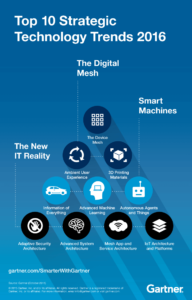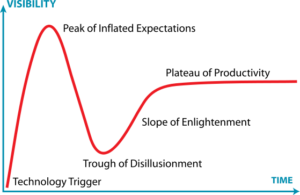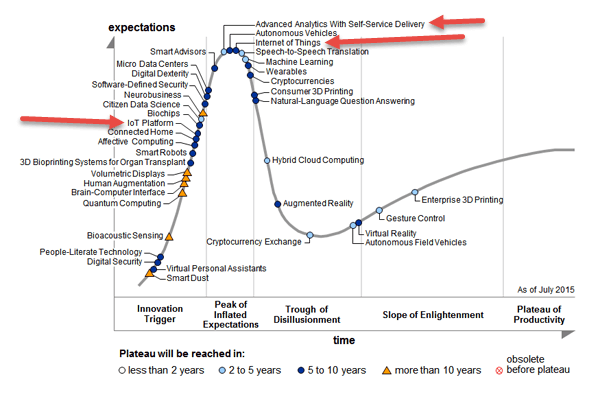Technology is growing fast as well as the amount of data and internet traffic. Big-Data is not new in discussion. The challenge is how to handle them on the one side and how to use them on the other side.
Let’s have a look on technology with a marketing view / direction.
There are plenty of marketing tools available on the market, most of them as a SaaS model. They all fight for the best features & functions. Before we can do the best marketing we need to handle the information and data which are available now and which should be available (stored somewhere and not connected). There should also be a thinking which data should be collected to do a better communication and reach sales & marketing goals.
So it is first to do some homework and then focus on tools like Adobe, Salesforce and other.
Why? Let’s have a look at these 2 statements:
Moore’s law: “Processor speeds, or overall processing power for computers will double every two years.”[ref]https://www.mooreslaw.org[/ref]
“Annual global IP traffic will pass the zettabyte (1000 exabytes) threshold by the end of 2016, and will reach 2 zettabytes per year by 2019″[ref]Forecast by Cisco – https://cisco.com…[/ref]
If we look at the amount of data it’s clear that there need to be a raise in technology. Think about to following point:
- There are plenty of information out
- Discover which information are relevant
- Discover how to use the information from a business view (no technology or feature & function)
- Differentiate between structured and unstructured data
- Decide which data are important in raw and which in aggregated form
Let’s see what Gartner & Forrester are thinking about technology trends:
Gartner
 Source: Garner[ref]2015: Top 10 Technology Trends Signal the Digital Mesh – https://www.gartner.com…[/ref] – (click on image to enlarge) |
The Digital MeshTrend No. 1: The Device Mesh Trend No. 2: Ambient User Experience Trend No. 3: 3D-Printing Materials Smart MachinesTrend No. 4: Information of Everything Trend No. 5: Advanced Machine Learning Trend No. 6: Autonomous Agents and Things The New IT RealityTrend No. 7: Adaptive Security Architecture Trend No. 8: Advanced System Architecture Trend No. 9: Mesh App and Service Architecture Trend No. 10: Internet of Things Architecture and Platforms Read more direct @ https://www.gartner.com… |
Forrester
Forrester 10 thesis1. Connectivity 2. Data-Analysis Software 3. APIs 4. Digital Customer Experience 5. Digital Security & Risk 6. Hyperconnected Customer 7. Technology Stage of Maturation 8. Infrastructure 9. Software & Brand-Building 10. BYOD (Bring Your Own Device) The picture with the 10 points and more @ https://blogs.forrester.com… |
Both (Gartner and Forrester) with a different view and direction, but also both arround (big) data, analysis and machines / automation. Both arround customers, their experiences and their devices.
I do not want to step in deeper here. If you are interested follow the links. I would like to go more in the detailed topics for business. How will technology help doing business through the next years. Gartner shows this very well with different “hype cycles” which follow a general evolution cycle.
 | Source[ref]https://en.wikipedia.org/wiki/Hype_cycle[/ref] |
Let’s pick up two important hype cycles to get an understanding in which direction technology, marketing and business is developing. Map this to your strategy and learn how to grow your business at the right time with the right instruments.
Hype Cycle for Emerging Technologies, 2015
 | Source[ref]Gartner’s 2015 Hype Cycle for Emerging Technologies Identifies the Computing Innovations That Organizations Should Monitor – https://www.gartner.com…[/ref] |
Internet of Things (IoT) is currently at the top of the “Peak of Inflated Expectations” while IoT Platforms is far behind and just an “Innovation Trigger”. Both needs 5-10 years too reach the plateau of productivity. Advanced Analytics as another important point is very close to IoT. and needs 2-5 years to reach the plateau of productivity.
This are things which needs to be there before you can think really into the direction of Real-Time Marketing . So you will not wonder if you look into the next hype cycle and see that Real-Time Marketing takes more than 10 years!
Hype Cycle for Digital Marketing, 2015
1111 | Source[ref]Content Marketing World 2015: Caution Flags for Content Marketers – https://blogs.gartner.com…[/ref] |
Maybe your are doing Real-Time Bidding (RTB) or Real-Time Advertising (RTA) today… Great! Most marketer who are doing this are doing more the bidding instead of the advertising, but even if you do Real-Time Advertising, this is not Real-Time Marketing at all.
I don’t think it is necessary to talk about the differences between advertising and marketing. Just to summarize:
- Bidding: Just the process to place an advertisement
- Advertising: Just the campaign(s) for the marketing message / goals
- Marketing: The entire communication strategy to reach the different goals
If it takes so long to be able to do Real-Time Marketing we should think about marketing automation with the direction Near-Time Marketing which is much easier than using real-time data. A perfect Near-Time Marketing strategy / concept is a great up-lift in marketing. Look on your competitors… are they doing this? I think no!! If you are there then you are ready to grow with the technology and go very easy more and more in the direction of Real-Time Marketing and use marketing techniques which are closer to the plateau of productivity like Content Marketing.
- What do you think, who will be the biggest player and winner from a technology point of view?
- How is technology causing your marketing?
- Where are you right now with Marketing Automation and Near-Time Marketing?
Feel free to write your thoughts as a comment!
